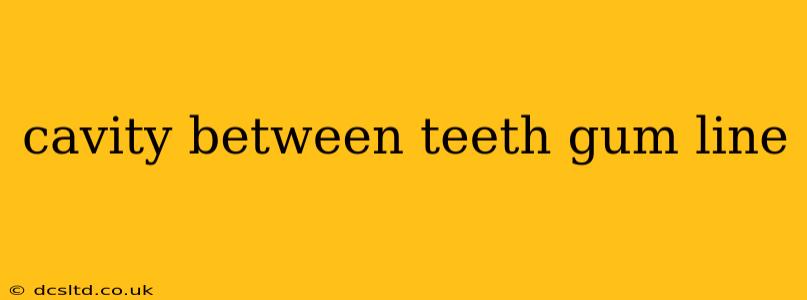A cavity between your teeth, near the gum line, is a serious dental concern. This location makes it particularly challenging to clean effectively, increasing the risk of decay and potentially leading to more significant dental problems. This article will explore the causes, symptoms, treatment, and prevention of cavities in this tricky area.
What Causes Cavities Between Teeth Near the Gum Line?
The primary cause of cavities, regardless of location, is plaque buildup. Plaque is a sticky film of bacteria that constantly forms on your teeth. These bacteria feed on sugar and produce acids that erode tooth enamel, leading to cavities. The area between teeth and near the gum line is particularly susceptible because:
- Difficult to Clean: Toothbrushes and floss struggle to reach this tight space effectively. Food particles and plaque can easily accumulate and remain undisturbed, providing a breeding ground for bacteria.
- Recessed Surfaces: The anatomy of teeth often creates crevices and grooves near the gum line where plaque can hide and thrive.
- Saliva Flow: Saliva helps neutralize acids produced by bacteria. The reduced saliva flow in this area allows acids to linger longer, increasing the damage to enamel.
Why is a Cavity Between Teeth Near the Gum Line Worse?
Cavities in this location are more problematic for several reasons:
- Progression: The cavity can quickly progress unnoticed due to the difficulty of self-examination. By the time you notice a problem, the decay may be more extensive, requiring more extensive treatment.
- Gum Involvement: If left untreated, the decay can spread to the gum tissue, leading to gum disease (gingivitis or periodontitis). This can cause inflammation, bleeding gums, and potentially tooth loss.
- More Complex Treatment: Repairing cavities in this area often requires more complex procedures than those on the more accessible surfaces of teeth. This may involve more extensive drilling or the use of specialized tools.
What are the Symptoms of a Cavity Between Teeth Near the Gum Line?
Unfortunately, early-stage cavities in this area often have no noticeable symptoms. As the cavity progresses, you might experience:
- Sensitivity to Temperature: Experiencing pain when consuming hot or cold foods or drinks.
- Pain When Chewing: Discomfort or pain while chewing, particularly on the affected side.
- Visible Discoloration: A dark spot or discoloration may become visible between your teeth. However, this is often only noticeable when the cavity is relatively advanced.
- Bad Breath: Persistent bad breath (halitosis) could also be indicative of a cavity.
How are Cavities Between Teeth Near the Gum Line Treated?
Treatment options depend on the severity of the cavity:
- Fluoride Treatment: For very early-stage cavities, fluoride treatments may help strengthen the enamel and prevent further decay.
- Filling: A filling is the most common treatment for cavities. The decayed area is removed, and the cavity is filled with a tooth-colored composite resin or amalgam.
- Crown: If the cavity is extensive, a crown (a cap that covers the entire tooth) may be necessary to protect the remaining tooth structure.
- Root Canal: In advanced cases where the decay reaches the pulp (the inner part of the tooth), a root canal may be required to remove the infected pulp and save the tooth.
- Extraction: In severe cases, extraction (removal of the tooth) may be the only option.
How Can I Prevent Cavities Between Teeth Near the Gum Line?
Prevention is key! Here's how to protect this vulnerable area:
- Meticulous Brushing: Use a soft-bristled toothbrush and brush gently but thoroughly, paying close attention to the gum line and between teeth. Use a fluoride toothpaste.
- Effective Flossing: Floss daily to remove plaque and food particles from between your teeth. Use a gentle back-and-forth motion. Consider using interdental brushes for better access in tight spaces.
- Regular Dental Checkups: Schedule regular checkups and professional cleanings. Your dentist can detect cavities early on when treatment is simpler and less invasive.
- Healthy Diet: Limit sugary and acidic foods and drinks.
- Fluoride Treatments: Discuss fluoride treatments with your dentist; these can strengthen tooth enamel and help prevent cavities.
What if I Neglect a Cavity Between My Teeth?
Neglecting a cavity, particularly one near the gum line, can lead to several serious consequences:
- Severe Tooth Decay: The cavity will continue to grow larger, potentially leading to tooth loss.
- Gum Disease: The infection can spread to the gums, causing gingivitis or periodontitis.
- Abscess: A painful abscess (a pocket of pus) can form at the root of the tooth.
- Bone Loss: In advanced stages, the infection can spread to the jawbone, causing significant bone loss.
- Need for More Extensive and Costly Treatment: Early detection and treatment are significantly more affordable and less invasive than dealing with advanced decay.
By understanding the causes, symptoms, and prevention strategies for cavities between teeth near the gum line, you can proactively protect your oral health and maintain a beautiful, healthy smile. Remember, regular dental checkups and a diligent oral hygiene routine are your best defense against cavities and other dental problems.
